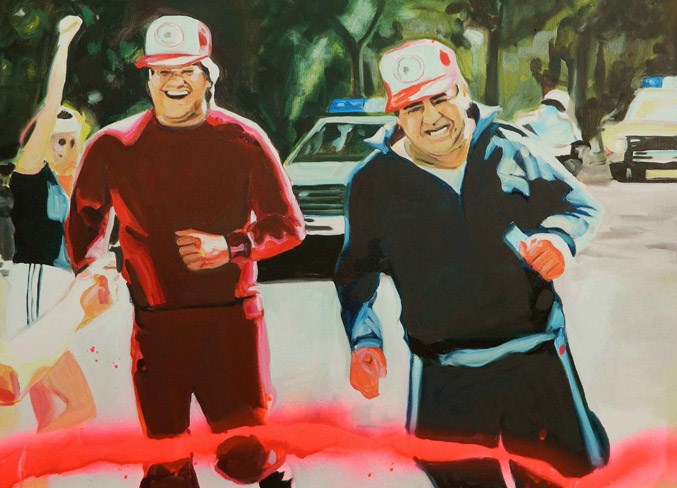Sam and Cliff: Pacing [“Fun Run”]
by Anna Marie Sewell
Sam Sinclair knew
politics is a runner’s game
pacing is everything.
The last time I saw him
Sam asked, ‘Who are you
working for now?’ I knew
just what he meant.
How do you serve the people?
It was given that I would. This
is what his generation
Raised our generation to do.
Sam, Cliff, Joanne, Thelma, Stan,
those oldtime politicians
toiled the long course 'til they won
Métis rights in the Law of our Land.
The race goes on.
Reconciling Edmonton will be on exhibit until March 30. Special programs focusing on RISEdmonton and the TRC will take place throughout February and March. Visit www.artgalleryofstalbert.ca/exhibitions-events/exhibitions/reconciling-edmonton for more information.
When reconciliation is the theme of your art exhibit – it’s right there in the title – it just makes some good solid sense to have different hands helping out, especially if you’re not necessarily planning to be the one to pick up the brush.
Miranda Jimmy of Reconciliation in Solidarity Edmonton (RISEdmonton for short) is not an artist. She calls herself a cultural connector and for a pretty compelling reason: she seems to have a knack for bringing people together, whether individually or in groups, and that includes entire cultures. RISEdmonton works its magic through workshops and public events, presentations, film screenings … pretty much any way it can.
Its obvious objective is the reinforcement of reconciliation between Canada’s Indigenous and non-Indigenous peoples. Its website (at www.risedmonton.ca) describes its mission as being “committed to raising awareness of the lasting impacts of residential school, creating safe spaces for conversations about reconciliation, and offering opportunities to learn more about and engage with Indigenous culture.”
An art exhibit was a necessary facet to the organization’s repertoire. To do so, Jimmy enlisted the services of Edmonton’s former historian laureate, Danielle Metcalfe-Chenail, visual artist Jennie Vegt and Edmonton’s former poet laureate, Anna Marie Sewell, with a task of many symbolic and touching layers.
First, of the four women, Jimmy and Sewell are Indigenous while Metcalfe-Chenail and Vegt are considered to be “settlers.” That’s collaborative reconciliation right there.
As the historian, Metcalfe-Chenail guided the group through retrieving seven photos from the archival record: seven instances of historic reconciliation between Indigenous and non-Indigenous people. The number seven was chosen as it represented the number of generations since the signing of Treaty Six. Vegt painted her interpretations of those images and those photos were then shared on RISEdmonton’s social media accounts. Sewell used her poetic licence by taking keywords from the public’s comments and creating her own original poems to accompany each piece.
The result is a powerful statement of beautiful written and visual art, a highly astute collaborative process, and a thoughtful look at both the past and the possibilities of the future.
For the creative contributors, much of the project was groundbreaking work.
To start, finding photographic evidence of reconciliation sounds like trying to find a needle in a haystack, except the haystack is impossibly large, and the needle is invisible. The historian was certainly up to the challenge and especially thankful for the help of her teammates.
“Writers and historians can be ‘lone wolves,’ but I think working with other creative, insightful people broadens our perspectives and challenges our assumptions,” Metcalfe-Chenail said. “What I learned from Anna Marie and Miranda is that the process is as important as the product, and that relationships are key.”
That process took them through the archives at both the municipal and provincial levels, and beyond.
“We definitely hit walls and were forced to look outside the Edmonton Archives for a couple of the photos because we couldn’t find everything we needed. This process helped us alert the archives staff as to outdated (and often damaging) filing names for Indigenous content, as well as blank spots in their holdings.”
They even went to the Aboriginal Multi-Media Society of Alberta and its Windspeaker Magazine to pore over the photo albums of the past. Once the seven images were determined, Vegt went to work. Presenting the photographs as is would turn the project into more of a museum exhibit rather than an art show. Vegt invested her artistic talents into each image as a way of honouring the past.
“Sometimes a painting can hold the power of hours physically invested to encourage other people to linger on it just a little longer than they would if it were a photograph. I tried to not overly change or interpret the images other than adding a little colour as I really wanted to keep it about the narrative in each image,” she noted.
“Sometimes, we were struck by the emotional resonances in public responses. Sometimes, we were made very aware of the lack of knowledge of our shared history, and tried to write so as to add knowledge, add historical insight, however well or poorly we might have done that,” Sewell said, adding she views life as a kind of truth and reconciliation and a process of integration, as she has both Polish and Indigenous (Anishinaabe and Mi'gmaq) heritage.
In the 1980s, her father worked to establish Métis rights in the Constitution, even though that definition, “perhaps ironically,” she notes, excluded her family. Still, she gets the same kind of feeling from her work with RISEdmonton as she did in her family home from those days.
“Nonetheless, I remember the excitement of those years, the sense that people were doing something that mattered, and that’s what I tried to depict in the poem for the photo of Sam Sinclair and Cliff Gladue.”
The exhibit runs until March 30, a date that should be noted is the exact fifth anniversary of final Truth and Reconciliation National Event in Edmonton.




